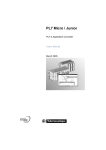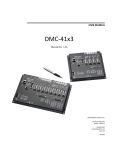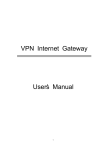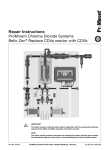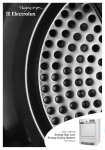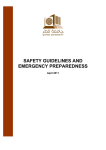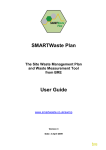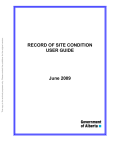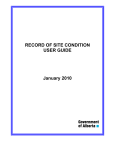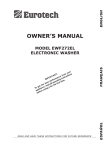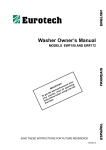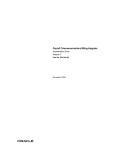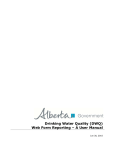Download Alberta User Guide for Waste Managers
Transcript
Alberta User Guide for Waste Managers PART 3 Approvals for Waste Management Facilities Includes a section-by-section guide to the Regulation and answers to the most commonly asked questions. March, 1995 ENVIRONMENTAL PROTECTION Environmental Regulatory Service Alberta User Guide for Waste Managers PART 3 Approvals for Waste Management Facilities Table of Contents ___________________________ A. Who needs to submit an EIA report? ___________________________ Who needs an AEPEA approval? ______________________________ B. Guide to the Regulation: Section-by-Sectio _____________________ Questions and Answers ________________________________ ___ ENVIRONMENTAL PROTECTION Alberta User Guide for Waste Managers PART 3 – A Approvals for Waste Management Facilities This section deals only with approvals required under AEPEA. Additional approvals for waste management facilities may be required by other regulatory agencies. Who needs to submit an environmental impact assessment (EIA) report? The first step in the approvals process is to determine whether an environmental impact assessment (EIA) report is required. The following waste management activities are subject to mandatory EIA screening (see subsections (z) and ( aa) of Schedule 1 of the Environmental Assessment (Mandatory and Exempted Activities) Regulation and Section 42(1) of AEPEA): • a hazardous waste incinerator that accepts hazardous waste from an off-site source; or • a landfill that accepts hazardous wastes from an off-site source. Further information regarding the EIA screening process is available from th Environmental Assessment Division at 427-6270. APPROVALS FOR WASTE MANAGEMENT FACILITIES 3/95, PART 3 - 1 Who needs an AEPEA approval? Sections 58 and 59 of AEPEA and Section 2 of the Activities Designation Regulation require an approval under AEPEA for the following activities: (this list is taken from the Schedule of the Activities Designation Regulation DIVISION 1: WASTE MANAGEMENT and the amendments of Sept. 22, 1993 have been incorporated). Excerpts from the Regulation are shown in bold type. Treatment (a) the construction, operation or reclamation of a fixed facility where more than 10 tonnes per month* of waste are treated including, without limitation, a facility using activated carbon adsorption, distillation, electrolytic techniques, hydrolysis, ion exchange, solvent extraction, membrane separation, air and steam stripping, evaporation, freeze crystallization, filtration, neutralization, chemical precipitation, photolysis, oxidation, reduction, dehalogenation, ozonation, separation, solidification stabilization, incineration, wet oxidation, pyrolysis, thermal oxidation, molten glass processes, deep shaft wet air oxidation, supercritical water oxidation, plasma systems, catalytic incineration, aerobic or anaerobic digestion or an enzymatic system in the treatment process, but not including an analytical laboratory or a facility that engages in research; *note: interpreted as also meaning 10,000 litres/month “Treat” is defined in 1(ppp) of the Act as: “to apply any method, technique or process, including, without limitation, neutralization and stabilization, that is designed to change the physical, chemical or biological character or composition of a substance”. This is interpreted as including even such operations as drying, dewatering, dismantling, and size reduction. Mobile facilities (b) the operation of a mobile facility carrying out any of the treatment processes referred to in clause (a) where it operates at one location for 5 consecutive days or more at a time and treats more than 10 tonnes of waste per month*; *note: interpreted as also meaning 10,000 litres/month Both of these conditions must be exceeded before an approval will be required. Fuel blenders (c) the construction, operation or reclamation of a facility for the collection and blending of hydrocarbons and organics to produce fuel that is derived from waste where more than 10 tonnes of waste per month are used for these purposes; note: interpreted as also meaning 10,000 litres/month APPROVALS FOR WASTE MANAGEMENT FACILITIES 3/95, PART 3 - 2 Land treatment (d) the construction, operation or reclamation of a facility where land treatment of waste is carried out in amounts greater tha 10 tonnes per month; note: interpreted as also meaning 10,000 litres/month Boilers and heaters (e) the construction, operation or reclamation of a facility where more than 10 tonnes per month of fuel derived from waste are burned in industrial boilers or industrial process heaters, if the fuel is from a source other than a facility governed by clause (c); note: interpreted as also meaning 10,000 litres/month Hazardous and recyclables storage (f) the construction, operation or reclamation of a facility (i) that is engaged only in the storage of hazardous recyclables and is not engaged in any other aspect of recycling them, and Here “engaged only in the storag e of hazardous recyclables” means the facility is not engaged in another activity that requires an approval under AEPEA, for example, a chemical manufacturing plant or other activity described under Division 2 of the Schedule of the Activities Designation Regulation. If the facility is engaged in some other “unscheduled” activity such as dry cleaning, then the facility will require an approval to store hazardous recyclables if A or B, below, are exceeded. (ii) at which (A) a hazardous recyclable is sto red for a continuous period of more than 365 days, or Here “for a continuous period of more than 365 days” means that a particular hazardous recyclable item remains at the plant (“gathering cobwebs”) for more than 365 days. If hazardous recyclable items are always on site, but each individual item moves off the plant site within 365 days of its arrival, then this section does not apply. (B) more than 10,000 litres of hazardous recyclables is stored at any one time; (note: interpreted as also meaning 10 tonnes) No approval is required for pesticide container storage sites controlled by a local authority. APPROVALS FOR WASTE MANAGEMENT FACILITIES 3/95, PART 3 - 3 Hazardous waste storage (g) the construction, operation or reclamation of a facility (i) that is engaged only in the storage of hazardous waste and is not engaged in any other aspect of the treatment of the waste, and Here “engaged only in the storage of hazardous waste” means the facility is not engaged in another activity that requires an approval under AEPEA, for example, a chemical manufacturing plant or other activity described under Division 2 of the Schedule of the Activities Designation Regulation. If the facility is engaged in some other “unscheduled” activity such as dry cleaning, then the facility will require an approval to store hazardous waste if A or B, below, are exceeded. No approval is required for pesticide container storage sites controlled by a local authority. (ii) at which (A) a hazardous waste is stored for a continuous period of more than 365 days, or Here “for a continuous period of more than 365 days” means that a particular hazardous waste item remains at th plant (“gathering cobwebs”) for more than 365 days. If hazardous waste items are always on site, but each individual item moves off the plant site within 365 days of its arrival, then this section does not apply. (B) more than 10,000 litres of hazardous waste is stored at any one time; (note: interpreted as also meaning 10 tonnes) Third party hazardous waste storage (h) notwithstanding clause (g), the construction, operation or reclamation of a facility where hazardous waste is stored and some or all of the hazardous waste is produced by a perso other than the owner of the facility; This means that if you store somebody else’s hazardous waste in any amount and for any length of time, then you need an approval. No approval is required for pesticide container storage sites controlled by a local authority. Recyclers (i) the construction, operation or reclamation of a facility for processing hazardous recyclables, except a facility for processing; (i) spent process and lube oil filters for volume reduction and liquid removal by compaction or draining, or (ii) recyclables in an amount less than 10 tonnes per month; (note: interpreted as also meaning 10,000 litres) APPROVALS FOR WASTE MANAGEMENT FACILITIES 3/95, PART 3 - 4 The processing of nonhazardous recyclables, such as tire shredding, glass pulverizing etc., does not require an AEPEA approval. However, if the operation is expected to have a significant adverse effect, it may be in the operator’s best interest to obtain an approval even if th activity is not listed. This is discussed in more detail at the end of this section. Industrial landfills (j) the construction, operation or reclamation of a landfill where hazardous or industrial waste is disposed of; note: industrial waste is defined in Section 3(d) of the Activities Designation Regulation as “waste that is generated by an industrial process or as the result of the construction, operation, demolition or reclamation of an industrial site, but does not include industrial wastewater effluent or gaseous emissions”. What is an industrial landfill? In turn, an industrial site is interpreted to mean: • a site at which any of the activities listed in Section 2 of th Schedule of Activities takes place. The Schedule of Activities is found at the back of the AEPEA, and includes the following: The construction, operation or reclamation of a plant, structur or thing for: (a) the manufacture or processing of petroleum products, (unless the waste is regulated by ERCB); (b) the manufacture or processing of natural gas, its products or its derivatives, (unless the waste is regulated by ERCB); (c) the manufacture or processing of chemical and allied products; (d) the manufacture or processing of pulp and paper products; (e) the manufacture or processing of stone, clay or glass products; (f) the manufacture or processing of cement and lime products; (g) the manufacture or processing of fertilizer products; (h) the manufacture or processing of primary metal or me al products; (i) the manufacture or processing of wood or wood products; (j) the manufacture of asphalt or ready-mixed concrete; (k) the processing of coal, heavy oil, oil sands or minerals, (unless the waste is regulated by ERCB); (l) the processing of food; (m) the manufacture or processing of secondary food products, beverages or animal by-products; (n) the generating of thermal electric power or steam; APPROVALS FOR WASTE MANAGEMENT FACILITIES 3/95, PART 3 - 5 (o) the generating of hydro-electric power; (p) the processing of wastewater sludges; (q) the application to land of non-livestock generated wastes, wastewaters and wastewater sludges; (r) the manufacture of animal feed; (s) seed cleaning or forage drying; (t) the storage, treatment, processing or disposal of hazardous waste; (u) the combustion of solid, liquid or gaseous fuels or wastes; (v) the storing and processing of hazardous recyclables; (w) the storing and processing of designated material; (x) the manufacture or use of biotechnology products; (y) the manufacture or processing of explosives; (z) the manufacture or processing of sulphur products; (aa)the storage, treatment, processing or disposal of batteries; (bb)the processing or mining of salt; (cc)the surface storage of brine associated with hydrocarbon storage facilities; (dd)the coating of pipe or wire; (ee)the cleaning of containers; (ff) the blending of chemicals and paints; (gg)the preserving of wood; (hh)the process of electroplating; or (ii) any other industrial, manufacturing or processing purpos (unless the waste is regulated by ERCB). This means that any landfill accepting industrial waste in Alberta, other than landfills accepting solely oilfield waste, need an approval under AEPEA. Section 243(10) of AEPE allows operators of this type of facility until January 1, 1995 to submit a completed application for an approval. APPROVALS FOR WASTE MANAGEMENT FACILITIES 3/95, PART 3 - 6 Container and drum washers (k) the construction, operation or reclamation of a facility for cleaning empty containers as defined in the Hazardous Waste Regulation where the nominal capacity of the facility is greater than 10,000 litres per day combined container volume; “Empty container” is defined in the Hazardous Waste Regulation (and in the Waste Control Regulation), as, “a container that contains less than 2.5 centimetres of residue at the bottom of th container or less than 3% of the original contents, whichever is th lesser amount”. Note that a “container” is defined in the Wast Control Regulation as “any portable device in which hazardous waste is stored”. This is interpreted to include any portable devic in which goods listed on Table 4 were held. Open burning (l) the burning of prohibited debris by means of an open fire. note: prohibited debris is defined in Section 3(k) of the Activities Designation Regulation and includes but is not limited to “animal cadavers; animal manure; pathological waste; non-wooden material; waste material from building or construction sites, excluding wooden materials that do not contain wood preservatives; combustible material in automobile bodies; tires; rubber or plastic, or anything containing or coated with rubber or plastic or similar substances, except rubber or plastic attached to shredded scrap steel; solid waste from sawmills or planing mills with an annual production in excess of 6500 cubic metres of lumber; used oil; wood or wood products containing substances for the purpose of preserving wood” . Oil field facility exemptio NOTE: 1 Clauses (a) to (l) do not apply if the activity referred to is carried out at an oilfield waste-related facility. (See definition in Section 3(h) of Activities Designation Regulation. A facility taking a mixture of oilfield and non-oilfield waste will be regulated by AEP, not by the ERCB.) Restriction and research exemptio NOTE: 2 The exemption provided in clause (a) in respect of a facility that engages in research does not apply to the facility’s carrying out a technology demonstration to determine the suitability of a waste treatment process prior to its commercial application if: (a) the technology used in the treatment process has not been used in Alberta before; (b) the operating period, excluding construction set-up time and decommissioning but APPROVALS FOR WASTE MANAGEMENT FACILITIES 3/95, PART 3 - 7 including down time, exceeds 3 months; or (c) the total amount of waste processed during the operating period exceeds 500 tonnes. Application forms Section 3(1) of the Approvals Procedure Regulation sets out the required contents of an application for an AEPEA approval. These requirements have been included in the application forms available from the Industrial Wastes Branch. Therefore, the applicant has no need to refer to Section 3(1) of the Approvals Procedure Regulation. The Director may waive any of these requirements or may ask for additional information to be included in an application for an approval ( S.3(1)(s) and S.3(2)of the APR). Additional information requirements for waste management facilities ar described in the application forms available from the Industrial Wastes Branch. Where an operation or undertaking consists of or includes more than one activit listed in the Schedule, the Director may issue one approval that covers all of th activities and comprises all of the required approvals (see Section 3 of th Activities Designation Regulation). APPROVALS FOR WASTE MANAGEMENT FACILITIES 3/95, PART 3 - 8 Alberta User Guide for Waste Managers PART 3 – B Guide to the Regulation Section-by-Section TABLE OF CONTENTS DIVISION 1 DIVISION 2 DIVISION 3 Guide to the Regulation Section-by-Section Waste Control Regulation Alberta Regulation 129/93 DefinitionsSection 1 HAZARDOUS WASTE ApplicationSection 2 Things that are not hazardous wasteSection 3 Personal identification numbers ( PINs)Section 4 ExemptionsSection 5 Form of manifestSection 6 Manifest completionSection 7 Generator’s and consignor’s manifest dutiesSection 8 Carrier’s manifes dutiesSection 9 Receiver’s manifes dutiesSection 10 Multiple carrier’s manifestSection 11 RecordsSection 12 Storing hazardous wasteSection 13 LandfillsSection 14 Standards for landfillsSection 15 ImportationSection 16 Dilution and divisionSection 17 Schedule 1 HAZARDOUS RECYCLABLES ApplicationSection 18 StorageSection 19 Recycle docketSection 20 InformationSection 21 ImportationSection 22 SECURITY Security requiredSection 23 Amount of securitySection 24 Adjustment of security requiredSection 25 Form of security Section 26 Return of securitySection 27 Retention of security Section 28 Forfeiture of securitySection 29 GENERAL OffenceSection 34 Due diligence defenseSection 35 TransitionalSection 36 * NOTE: Sections 30 to 33 do not apply to this guide. ENVIRONMENTAL PROTECTION Note: This information is a guide only, and does not take precedence over the legislation. The changes made under the Waste Control Amendment Regulation (257/93 September 22, 1993) have been incorporated here. Excerpts from the Regulation are shown in bold typeface. Section 1 Definitions In this Regulation, (a) “Act” means the Environmental Protection and Enhancement Act; The Act and the Regulations are available from the Queen’s Printer at 427-4952 in Edmonton or 297-6251 in Calgary. (b) “carrier” means a person who accepts hazardous waste for transportation or transports hazardous waste; The Hazardous Waste Carrier Registration form is included in Part 2 of this Guide. (c) “consignor” means a person who consigns hazardous waste for storage, transportation, treatment or disposal; The Hazardous Waste Consignor Registration form is included in Part 2 of this Guide (d) “container” means any portable device in which hazardous waste is stored; (e) “Director” means the person designated as Director for the purposes of this Regulation by Ministerial order; (f) “dispersible form” means any of the following or a mixture o them: (i) a liquid; (ii) a solid that can pass through a 9.5 mm mesh opening; (iii) a friable solid that can be reduced by grinding in a mortar and pestle to a particle size that can pass through a 9.5 mm mesh opening; Dispersible forms are discussed in Part 1B - Compilation of Test Methods. Wastes which are not in a dispersible form are not subject to the leachate test and are not considered to be hazardous based on what they contain. They may however, be hazardous based on their properties such as flammability, corrosivity, toxicity, etc. (g) “dispose” with respect to waste means to intentionally place waste on or in land as its final resting place; The term “dispose” is used in Sections 14.1, 14.3, and 14.4 which describe landfill prohibitions. The term is also used in Section 16 which deals with importation. For the purposes of Section 16, disposal is interpreted to mean intentionally placing waste on or in GUIDE TO REGULATION, SECTION-BY-SECTION 3/95, PART 3-11 land, air, or water as its final resting place. For example, a person would not be allowed to import waste for the purpose of disposing of it into a river. (h) “empty container” means a container that contains less than 2.5 centimetres of residue at the bottom of the container or less than 3% of the original contents, whichever is the lesser amount; (i) “farmer” means a person engaged in primary production in an agricultural, horticultural or arboricultural operation for financial gain (j) “Federal Regulations” means the Transportation of Dangerous Goods Regulations (SOR/85-77) made under the Transportation of Dangerous Goods Act, 1992 (Canada); (k) “hazardous recyclable facility” means a facility for storing and processing hazardous recyclables; (l) “hazardous waste” means waste described in Schedule 1, but does not include oilfield waste or waste excluded by section 3; Oilfield wastes are excluded from the definition of hazardous waste and are not regulated under the Waste Control Regulation. For example, the manifesting requirements do not apply to oilfield waste. However, oilfield wastes are regulated by the ERCB in a manner equivalent to the requirements of the Waste Control Regulation. (m) “hazardous waste management facility” means a facility for the collection, storage, treatment or disposal of hazardous waste, but does not include an on-site facility; This term is used only in Sections 12(1) “Records” and 23(a) “Security Required” of this Regulation. (n) “heavy oil site” means the field production facilities for recovering heavy oil by drilling and includes any injection or pumping facilities, any associated infrastructure and any processing facilities; (o) “internal volume” means the nominal capacity of a container; (p) “liquid hazardous waste” means hazardous waste that is a liquid as determined by a method specified by the Director; The term “liquid” is defined in Part 1B of this User Guide Compilation of Test Methods. (q) “oilfield waste” means an unwanted substance or mixture o substances that results from the construction, operation or reclamation of a well site, oil and gas battery, gas plant, compressor station, crude oil terminal, pipeline, gas gathering system, heavy oil site, oil sands site or related facility; Oilfield wastes are excluded from the definition of hazardous waste. (see Section 1(L)). Oilfield wastes, regardless of their GUIDE TO REGULATION, SECTION-BY-SECTION 3/95, PART 3-12 properties or composition, are regulated by the ERCB in a manner equivalent to this Regulation. Examples of oilfield wastes may include even such things as PCBs or mercury if they are generated at a compressor station, gas plant, etc. Oilfield wastes remain oilfield wastes from “cradle-to-grave” and, once generated, ar never regulated under the Waste Control Regulation. (r) “oil sands site” means the field production facilities for recovering oil sands by drilling or other in situ recovery methods and includes any injection or pumping facilities, any associated infrastructure and any processing facilities; Waste generated at mining oilsand sites is not called oilfield wast and is not excluded from the Waste Control Regulation. (s) “on-site facility” means a facility that is used solely to deal with hazardous waste generated on property owned by the owner of the facility; This definition is used only in the definition of a hazardous wast management facility. (t) “receiver” means a person who receives hazardous waste for storage, treatment or disposal; The Hazardous Waste Receiver Registration form is included in Part 2 of this Guide. For the purposes of this definition, disposal is interpreted to mean intentionally placing waste on or in land, air, or water as its final resting place. (u) “unrinsed empty container” means an empty container that previously held a hazardous waste; (i) that has not been rinsed 3 times, using for each rinse a clea solvent that is in an amount equal to 10% of the container volume and that is capable of removing the previously contained hazardous waste, or (ii) that, in the opinion of the Director, has been rinsed or cleaned by a method that does not produce results equal to or better than those produced by the method set out i subclause (i). In the absence of any analytical work or knowledge to the contrary, the rinsate should be assumed to be hazardous and should b managed as such. Rinsates from pesticide containers are excluded if the container held a pesticide listed on Schedule 3 or 4 of the Pesticide (Ministerial) Regulation, or if they are in the possession of a farmer, or while being transported to or managed within a collection system controlled by a local authority. GUIDE TO REGULATION, SECTION-BY-SECTION 3/95, PART 3-13 Division 1 Hazardous Waste Section 2 Application This Division does not apply to hazardous waste handled as a hazardou recyclable under Division 2 rather than as a hazardous waste. The following exclusions are discussed in Part 1A - Step 2 of this Guide Section 3 Things that are not hazardous waste The following exclusions are discussed in detail in Part 1A - Step Two of this Guide. The following are not hazardous waste for the purposes of the Act or th Regulations under the Act: (a) household waste in the possession of the householder or while unsegregated in a municipal waste management system (b) wastes generated by farmers in (i) the growing and harvesting of crops, or (ii) the raising of animals, including animal manures returned to the soil as fertilizers; (c) domestic sewage; (d) radioactive wastes regulated under the Atomic Energy Control Act (Canada); (e) wastes resulting from emergency spill clean-ups, if the Director or an investigator has authorized the handling of the clean-up debris; (f) biological waste and pathological waste as defined in the Waste Management Regulation (Alta. Reg. 250/85) under the Public Health Act; (g) waste described in Schedule 1 (other than those substances listed in Table 4, Part B of the Schedule of the Alberta User Guide for Waste Managers published by the Department, as amended from time to time) that is produced in an amount less than 5 kilograms per month if a solid or 5 litres per month if liquid and the total quantity accumulated does not exceed 5 kilograms or 5 litres at any one time; (h) waste resulting from the treatment of hazardous waste where the treatment employs a method, technique or process that represents acceptable industry practice. These “acceptable” practices are listed in Part 1A of this Guide, for example, the methods used to sparge drycleaning filters with steam. “Acceptability” is determined by the Director. In making this decision the Director will ask questions such as: • • Is the waste generated in small quantities? Is the waste produced by a small business? GUIDE TO REGULATION, SECTION-BY-SECTION 3/95, PART 3-14 • •Is the waste treated at the site where it is generated? • •Is the waste being treated by the generator? Generators who can answer “yes” to these questions will be more likely to receive an exemption. Section 4 Personal identification numbers (PINs) An application for a personal identification number (PIN) under sectio 179(2) of the Act must be submitted to the Director in a form acceptable to the Director. Section 5 Exemptions Sections 179 and 182 of the Act do not apply to a person who consigns, transports or accepts for transportation a hazardous waste from the site on which the hazardous waste is produced to another site that is owned by the same person who owns the site on which the hazardous waste is produced, i Section 6 Form of manifest Application forms for consignors, carriers and receivers are included in Part 2 of this Guide. (a) the person in charge of the vehicle transporting the hazardous waste displays on the vehicle a placard that corresponds to th placard set out as Figure 19 in Part III of Schedule V of the Federal Regulations, and (b) the shipment is accompanied by a shipping document that shows the hazard class, the emergency response contact, the total mass or volume of each of the hazardous wastes to whic the shipping document relates and the number of packages, where applicable. The manifest referred to in Section 182 of the Act must be in the form for the manifest set out in the federal Regulations. These forms are available from the Industrial Wastes Branch at 427-5847. Section 7 Manifest Completion The section “How to complete the manifest form” is in Part 2 of this Guide The consignor, carrier and receiver of a hazardous waste shall complete the applicable parts and copies of the manifest to the satisfaction of the Director. GUIDE TO REGULATION, SECTION-BY-SECTION 3/95, PART 3-15 Section 8 Generator’s and consignor’s manifest duties (1) (2) Section 9 Carrier’s manifest duties Section 10 Receiver’s manifest duties A consignor, on consigning a hazardous waste, shall; (a) sign all copies of the manifest, and ensure that the carrier certifies receipt of the hazardous waste, (b) mail the first copy of the manifest to the Director within 2 days, excluding Saturdays and holidays, after consigning the hazardous waste, (c) retain the 2nd copy for at least 2 years following the consignment, and (d) deliver the 3rd, 4th, 5th and 6th copies to the carrier. The consignor of hazardous waste that is shipped out of Alberta shall ensure that a copy of the manifest completed by the out-of-province receiver is given to the Director, the carrier, the consignor and, if the waste is shipped out of Canada, to Environment Canada. A carrier, on accepting hazardous waste for transportation, shall; (1) (a) sign all copies of the manifest, (b) return the first and 2nd copies of the manifest to the consignor, (c) ensure that the 3rd, 4th, 5th and 6th copies accompany the hazardous waste during transportation, and (d) deliver the 3rd, 4th, 5th and 6th copies to the receiver. A receiver, on accepting hazardous waste for storage, treatment or disposal, shall; (a) (b) (c) (d) sign the 3rd, 4th, 5th and 6th copies of the manifest and return the 4th copy to the carrier, mail the 3rd copy to the Director within 2 days, excluding Saturdays and holidays, after receiving the hazardous waste, retain the 5th copy for at least 2 years after receiving the hazardous waste, and mail the 6th copy to the consignor within 2 days, excluding Saturdays and holidays, after accepting the hazardous waste. (2) The receiver of hazardous waste generated outside of Alberta shall ensure that the Director (and, if the waste was generated outside o Canada, Environment Canada) receive a copy of the manifest. (3) The consignor shall retain the 6th copy of the manifest referred to i subsection (1)(d) for at least 2 years following its receipt from the receiver. GUIDE TO REGULATION, SECTION-BY-SECTION 3/95, PART 3-16 Section 11 Multiple carrier’s manifest (1) If multiple carriers are used for a consignment of hazardous waste, (a) the consignor shall complete a separate manifest and comply with section 8 with respect to each carrier; (b) each carrier, on accepting hazardous waste for transportation, shall (c) (i) sign one manifest form and return copies 1 and 2 of that form to the consignor, and (ii) deliver the remaining copies and remaining manifest forms to the receiver or next carrier; the receiver shall, on accepting the hazardous waste for storage, treatment or disposal, (i) sign the 3rd, 4th, 5th and 6th copies of all manifest forms, (ii) cross-reference all of the manifests, (iii) mail the 3rd copy of each manifest form to the Director within 2 days, excluding Saturdays and holidays, after accepting the hazardous waste, Section 12 Records (iv) mail the 4th copy of the appropriate manifest to each carrier, (v) retain the 5th copy of each manifest for at least 2 years after receiving the hazardous waste, and (vi) mail the 6th copy to the consignor within 2 days, excluding Saturdays and holidays, after accepting the hazardous waste. (2) The consignor shall retain the 6th copy of the manifest referred to i subsection (1)(c)(vi) for at least 2 years following its receipt from the receiver. (1) Subject to any terms and conditions of an approval, the Director may, by notice in writing to an operator of a hazardous waste management facility, require the operator to keep records in the form and manner and containing the information specified by the Director in the notice. Note that the definition of a hazardous waste management facility does not include an “on-site facility”. Therefore, an on-site facility would not b regulated under this section. (2) An operator who receives a notice under subsection (1) shall comply with it. (3) An operator shall keep information in a record referred to in subsection (1) for at least 5 years after the information was entered i the record. An AEPEA approval may require records to be kept for longer than 5 years. Operators of hazardous recyclable facilities should refer to Section 21 of GUIDE TO REGULATION, SECTION-BY-SECTION 3/95, PART 3-17 this Regulation which deals with information retention requirements. Section 13.1(5) describes the information requirements for a person storing PCB waste. Section 13 Storing hazardous waste (1) A person who stores hazardous waste shall store it in an amount and i a manner so that; (a) it will not cause an adverse effect, An adverse effect is defined in Section 1(b) of the Act as impairment of or damage to the environment, human health or safety, or property. (b) any leakage is contained and prevented from entering into the remainder of the storage site and places beyond, including sewers and the ground underneath the site, and (c) at least secondary containment is provided for liquid hazardou waste, and there are no openings in the secondary containment system that provide a direct connection to the area surrounding the system, (d) the hazardous waste is adequately labelled, stating the identity of the hazardous waste that is being stored, (e) incompatible hazardous wastes are stored in such a manner that there will be no contact between them, even in the event of release, and (f) (2) routine inspections of the storage site can be performed. A person who stores hazardous waste shall ensure that the waste is stored in a place that (a) is secure from entry by unauthorized persons, (b) is prominently identified as a hazardous waste storage site, (c) is equipped with suitable equipment to handle emergency situations, (d) is provided with operators trained to respond to emergency situations specific to the waste stored, an (e) is designed and maintained so that surface run-off water cannot enter the secondary containment system. (3) Subsection (2)(b) applies only to a storage site whose only function is the storage of hazardous waste, and does not apply to a storage site that is located in or is part of a larger manufacturing, processing or other operation. AEPEA approvals may set out additional requirements for hazardous wast storage. GUIDE TO REGULATION, SECTION-BY-SECTION 3/95, PART 3-18 Section 13.1 Storage of PCBs Section 13.1 is added after section 13: in accordance with the Waste Control Amendment Regulation 257/93 of September 22, 1993. (1) In this section, (a) “PCB” means chlorobiphenyls that have a molecular formula of C12H10 -nCln, in which “n” is greater than 2; (b) “PCB equipment” means any equipment, machinery or similar manufactured item, including a capacitor and an electrical transformer, that contains a PCB liquid, PCB solid or PCB substance; (c) “PCB liquid” means a liquid that contains more than 50 mg o PCBs per kilogram of the liquid; (d) “PCB solid” means a solid that contains more than 50 mg of PCBs per kilogram of the solid; (e) “PCB substance” means a substance, other than PCB liquid or PCB solid, that contains more than 50 mg of PCBs per kilogram o the substance; (f) “PCB waste” means any PCB liquid, PCB solid, PCB substance or PCB equipment that is stored as waste. (2) In determining the quantity, volume or weight of PCB waste for the purposes of subsection (3), the total amounts stored in or around one site that is under the responsibility of the same person shall be added together. (3) Subject to the terms and conditions of an approval, a person who stores PCB waste in the following amounts shall register with the Director i accordance with subsection (4) and keep and provide records i accordance with subsections (5) and (6): A person who holds an approval to store PCB waste does not need to register with the Director. An approval holder is considered to be registered. person who on the coming into force of this Regulation is registered as required under Ministerial Order No. 04/89 dated March 4, 1989 is also deemed to be registered under this section, and does not need to reregister (S. 36.1 Waste Control Amendment Regulation) (a) PCB liquids in an amount of 100 L or more; (b) PCB solids or PCB substances in an amount of 100 kg or more; (c) PCB liquids, PCB solids or PCB substances or a combination o any of them, in an amount less than that referred to in clause (a) or (b), that contain one kg or more of PCB; (d) PCB equipment that contains an amount of PCBs, PCB liquids, PCB solids or PCB substances referred to in any o clauses (a) to (c). GUIDE TO REGULATION, SECTION-BY-SECTION 3/95, PART 3-19 Section 13.1 continued (4) (5) An application for registratio a) must be made not later than 30 days after the person first stores PCB waste in amounts referred to in subsection (3), and (b) must disclose the name of the person, the location of the storage site and a description and inventory of the PCB waste that is stored at the site. The records referred to in subsection (3) must contain the following information: (a) (b) (c) with respect to each item of PCB waste received at the storage site, (i) the date of receipt of the PCB waste, (ii) the quantity of PCB waste received, (iii) a description of the PCB waste, including, where applicable, the nameplate description, the serial number and the PCB registration number, (iv) the condition of the PCB waste, (v) the source of the PCB waste, (vi) the name of the carrier of the PCB waste, and (vii) the name of the individual who received the PCB waste; with respect to each item of PCB waste removed from the storage site, (i) the date of removal of the PCB waste, (ii) a description of the PCB waste, including, where applicable, the nameplate description, (iii) the condition of the PCB waste, (iv) the name of the carrier of the PCB waste, (v) the destination of the PCB waste, and (vi) the name of the individual authorizing the removal of the PCB waste; the results of any inspections conducted and any action taken as a result of those inspections. A person who keeps records under subsection (5) shall provide a copy of the records to the Director on January 1 and July 1 of each year containing the required information for the preceding 6 month period. For practical reasons, the person is allowed a grace period of 30 days following these dates to submit this information to the Director. No enforcement action will be considered during this grace period. It is often impossible for a person to compile the information and submit it on the same day. GUIDE TO REGULATION, SECTION-BY-SECTION 3/95, PART 3-20 Section 14 Landfills (1) No person shall dispose of hazardous waste into a landfill. Do not confuse these landfill restrictions with the definition of hazardous wastes given in Section 1 (L). Hazardous waste landfill approvals issued under AEPEA prohibit many of the following wastes from being accepted at the landfill. That is, the landfill approval is often more restrictive than this Regulation. See also Figure 5. (2) Subsection 1 does not apply to a person disposing of the following types of hazardous waste in the applicable landfill as described in subsectio (3) or (4): In order to be legally landfilled, the hazardous waste must meet ALL of th following requirements. The determination of whether a waste is restricted occurs at the point of generation. A generator may use knowledge of th waste to determine if it is subject to the land disposal restriction; however, documentation substantiating this determination must be kept on th generator’s files. Subsequent dilution to make the waste nonhazardous or to make a waste landfillable is prohibited by Section 17(1) of this Regulation. Recirculation of leachate within a cell at a landfill is acceptable even if th leachate is so concentrated that it exceeds the landfill prohibitions. This practice is not considered to be “disposal” under Sections 14(1) and 14(2) of the Waste Control Regulation. The associated Test Methods are described in Part 1B - Compilation of Test Methods. (a) solid hazardous waste containing one or more halogenated organic compounds in a total combined concentration less tha 1000 milligrams per kilogram; (b) liquid hazardous waste containing one or more halogenated organic compounds in a total combined concentration less tha 100 milligrams per kilogram, of which no more than 50 milligrams per kilogram is polychlorinated biphenyl; (c) liquid or solid hazardous waste containing one or more of the following compounds in a total combined concentration less tha 1000 milligrams per kilogram: • acetone • isobutanol • benzene • methanol • n-butyl alcohol • methyl ethyl ketone • carbon disulfide • nitrobenzene • cresols and cresylic acid • 2-nitropropane • cyclohexanone • pyridine • ethyl acetate • toluene • ethyl benzene • xylene • ethyl ether GUIDE TO REGULATION, SECTION-BY-SECTION 3/95, PART 3-21 (d) any substance or mixture of substances that ignites and propagates combustion according to the test methods that describe spontaneously combustible hazardous waste, provided that those substances or mixtures of substances; (i) (e) (f) (g) (h) are not liable to ignite and propagate combustion under the conditions of disposal, and (ii) are not liable to emit flammable gases under the conditions of disposal; liquid hazardous waste containing any of the following substances in a concentration less than that shown: Arsenic 500 milligrams per kilogram; • Berylliu 100 milligrams per kilogram; • Cadmium 100 milligrams per kilogram; • chromium hexavalent 500 milligrams per kilogram; • lead 500 milligrams per kilogram; • mercury 20 milligrams per kilogram; • nickel 500 milligrams per kilogram; • selenium 200 milligrams per kilogram; • silver 100 milligrams per kilogram; • thalliu 200 milligrams per kilogram; • uranium 100 milligrams per kilogram; • solid hazardous waste producing a waste extract which contains one or more of the substances referred to in clause (e) in a concentration less than the value for that substance shown in that clause; liquid hazardous waste containing less than 1000 milligrams per kilogram of free cyanides; hazardous waste with a pH greater than 12.5. Wastes with a pH greater than 12.5 may be placed in landfills which have been approved for this purpose (provided the waste is not prohibited from landfills for some other reason). Wastes with a p less than 2 may not b landfilled in Alberta. A pH in the range of 2 to 12.5 does not make a waste hazardous and these wastes may b landfilled at an approved landfill (again, provided they are not otherwise prohibited). (3) No person shall dispose of liquid hazardous waste described in subsection (2) in a landfill unless the landfill has; (a) 2 liners of which at least one is a synthetic liner, (b) a leachate collection and removal system, (c) a leak detection system between the 2 liners, and (d) a groundwater monitoring system. GUIDE TO REGULATION, SECTION-BY-SECTION 3/95, PART 3-22 (4) No person shall dispose of solid hazardous waste described in subsectio (2) in a landfill unless the landfill has; (a) a synthetic or clay liner, (b) a leachate collection and removal system, and (c) a groundwater monitoring system. There is no transitional grace period for the requirements of 14(3) or 14(4) for existing landfills. Approvals issued under AEPEA may include additional requirements for landfills. GUIDE TO REGULATION, SECTION-BY-SECTION 3/95, PART 3-23 Section 15 Standards for landfills No person shall construct or operate a landfill that accepts hazardous waste; (a) in a 100-year floodplain unless the landfill is designed, constructed, operated and maintained to prevent washout of any hazardous waste by a 100-year flood, (b) within 100 m of any land that is subject to slope failure, (c) within a wetland area or an area immediately adjacent to a wetland area so that natural drainage from the landfill would flow directly into the wetland area, (d) in a recharge area of an unconfined aquifer, or (e) within 300 m of a watercourse. The term watercourse is defined in Section 1 (www) of AEPEA as: (i) the bed and shore of a river, stream, lake, creek, lagoon, swamp, marsh or other natural body of water, or (ii) a canal, ditch, reservoir or other man-made surface feature, whether it contains or conveys water continuously or intermittently; For the purposes of the Waste Control Regulation, the term watercourse does not include any natural body of water or a man-made surfac feature which: flows or contains water only during or immediately after rainfall or • snowmelt, exhibits little or no channel, bank or shore development, and • •whose channel or bed is vegetated. • Also, the term watercourse does not include a roadside ditch for th purposes of the Waste Control Regulation. There is no transitional grace period for these requirements. Approvals issued under AEPEA may include additional requirements for landfills. GUIDE TO REGULATION, SECTION-BY-SECTION 3/95, PART 3-24 Section 16 Importation (1) No person shall knowingly import any hazardous waste into Alberta for the purpose of storage for a period exceeding 30 days without first obtaining writte authorization from the Minister. Also, no authorization is required for waste-in-transit which is picked up in Alberta and proceeds through Alberta, provided it is not stored on the truck for more than 30 days. (2) No person shall knowingly import hazardous waste into Alberta for the purpose of disposal. (3) Subsection (2) does not apply to the disposal of residues resulting fro the treatment of imported hazardous waste. “Disposal” is interpreted to mean intentionally placing waste on or in land, air, or water as its final resting place. For example, a person would not b allowed to import waste for the purpose of disposing of it into a river. “Treat” is defined in 1(ppp) of the Act as: “to apply any method, technique or process, including, without limitation, neutralization and stabilization, that is designed to change the physical, chemical or biological character or composition of a substance”. This is interpreted as including even such operations as drying, dewatering, dismantling, and size reduction. For shipments entering or leaving Alberta, whether hazardous recyclables or hazardous waste, generators must classify, name and label their waste in strict compliance with the Transportation of Dangerous Goods legislation. Wastes considered “hazardous” or “special” in other jurisdictions or under TDG legislation are subject to review by the Director before importation for storage, treatment or disposal will be authorized. The importation of oilfield waste (even with hazardous properties) is regulated by the ERCB. Section 17 Dilution and division (1) No person shall mix hazardous waste with any solid or liquid for the primary purpose of dilution or of avoiding the requirements of this Regulation. This section does not apply to stabilization or solidification technologies or to neutralization of acids or bases. (2) No person shall divide a hazardous waste for the primary purpose o avoiding the requirements of this Regulation. GUIDE TO REGULATION, SECTION-BY-SECTION 3/95, PART 3-25 Schedule 1 (1) Waste is hazardous waste if, when tested according to test methods prescribed by the Director, One should not confuse this definition of hazardous waste with the landfill restrictions of Section 14. Keep in mind that some hazardous wastes may b landfilled at some approved landfills in Alberta. The test methods are described in Part 1B - Compilation of Test Methods. (a) it has a flash point of less than 61°C, (b) it ignites and propagates combustion in a test sample, (c) it contributes oxygen for combustion at a rate that is equal to or greater than that provided by ammonium persulphate, potassiu perchlorate or potassium bromate, (d) it is toxic because it (i) has an oral toxicity LD50 not greater than 5000 mg/kg, Toxicity is discussed in detail in Part 1B - Compilation of Test Methods. (ii) has a dermal toxicity LD50 not greater than 1000 mg/kg, or (iii) has an inhalation toxicity LC50 not greater than 10,000 mg/m3 at normal atmospheric pressure, (e) it has a pH value less than 2.0 or greater than 12.5, (f) it contains polychlorinated biphenyls at a concentration equal to or greater than 50 mg/kg, or PCB waste must be in a dispersible form or be PCB equipment. The test method is based on totals, not leachate. (g) it is a toxic leachate because it is in a dispersible form and; (i) it contains at a concentration of 100 mg/L or higher any substance listed in Table 1 of the Schedule of the Alberta User Guide for Waste Managers, published by the Department, as amended from time to time, (ii) its leachate contains any substance listed in Table 2 of the Schedule of the Alberta User Guide for Waste Managers, published by the Department, as amended from time to time in excess of the concentrations listed in that Table, or (iii) is contains any of the following substances in a concentration greater than 0.001 mg/L: hexachloro-dibenzo-p-dioxins pentachloro-dibenzo-p-dioxins tetrachloro-dibenzo-p-dioxins hexachloro-dibenzofurans pentachloro-dibenzofurans tetrachloro-dibenzofurans Sections 1 (g)(i), (ii) and (iii) are all based on the Toxicity Characteristic Leaching Procedure (TCLP) leachate test. GUIDE TO REGULATION, SECTION-BY-SECTION 3/95, PART 3-26 (2) The following waste is hazardous waste: (a) waste types listed in Table 3 of the Schedule of the Alberta User Guide for Waste Managers, published by the Department, as amended from time to time; (b) commercial products or off-specification products listed in Part A of Table 4 of the Schedule fo the Alberta User Guide for Waste Managers, published by the Department, as amended from time to time; (c) a container, other than an empty container, that has an internal volume greater than 5 liters and contains a substance listed i Part A of Table 4 of the Schedule of the Alberta User Guide for Waste Managers, published by the Department, as amended from time to time; Containers are discussed in Part 1A - Step Three of this Guide. (d) a number of containers, other than empty containers, that have an aggregate internal volume greater than 5 litres and contained a substance listed in Part A of Table 4 of the Schedule of the Alberta User Guide for Waste Managers, published by the Department, as amended from time to time; (e) commercial products or off-specification products listed in Part B of Table 4 of the Schedule of the Alberta User Guide for Waste Managers, published by the Department, as amended from time to time; (f) an unrinsed empty container that has an internal volum greater than 5 litres and contained a substance listed in Part B of Table 4 of the Schedule of the Alberta User Guide for Waste Managers, published by the Department, as amended from time to time; Containers are discussed in Part 1A - Step Three of this Guide. (g) a number of unrinsed empty containers that have an aggregate internal volume greater than 5 litres and contained a substance listed in Part B of Table 4 of the Schedule of the Alberta User Guide for Waste Managers, published by the Department, as amended from time to time; GUIDE TO REGULATION, SECTION-BY-SECTION 3/95, PART 3-27 Division 2 Hazardous Recyclables Section 18 Application (1) This Division does not apply to hazardous waste that is handled as hazardous waste under Division 1 rather than as a hazardous recyclable. Note that the definition of recycling in Section 1(ddd) of AEPEA excludes land application or thermal destruction. Thermal destruction is interpreted to mean thermal destruction without any benefit or heat recovery. Therefore, if hazardous material is burned as a fuel, then it is a hazardous recyclable. (2) Section 162 of the Act and Section 20 of this Regulation do not apply to the consigning for shipment as a hazardous recyclable of less than 205 litres or less than 205 kilograms of hazardous waste referred to i Section 3(g). This means a recycle docket is not required if a pickup is less than 205 litres or kilograms. If the truck is on a multiple pick-up run it may pick up a combined total of more than 205 litres or kilograms without any recycl dockets, ONLY IF each single pick-up is less than 205 litres or kilograms. The need to consign only to approved recycling facilities is also waived by this section. The words “of hazardous waste referred to in Section 3(g)” should be deleted from the Regulation. Section 19 Storage Refer to Sectio 13 which sets out the storage requirements for hazardou waste. Section 20 Recycle docket The recycle docket referred to in Section 162 of the Act must; (a) meet the requirements for the shipping document for dangerous goods described in subsection 4.8(1) of the federal Regulations, and (b) have an attachment showing (i) the name of the consignor of the hazardous recyclable i the shipment, (ii) the location from which the hazardous recyclable in the shipment originated, (iii) the amount of hazardous recyclable in the shipment, and (iv) the signature of a authorized representative for the consignor of the hazardous recyclable in the shipment. Recycle dockets are discussed and a recommended format is provided in Part 2 of this Guide. GUIDE TO REGULATION, SECTION-BY-SECTION 3/95, PART 3-28 Section 21 Information An operator of a hazardous recyclable facility shall; (a) keep the following information for at least 2 years from the last day of the year in which the information was produced: (i) copies of all recycle dockets for hazardous recyclables received at the facility; (ii) a record of releases of substances at the facility; (iii) calibration and maintenance records of monitorin equipment; (iv) the results of all physical inventories of hazardous recyclables at the facility; (v) any other information prescribed in a notice in writing by the Director; (b) make the information available to the Director on the Director’s request in writing. This information shall also be made available to the Director’s representative, an inspector or an investigator of Alberta Environmental Protection. An approval may require retention of the above (and other) information for a period of more than 2 years. Section 22 Importation No person shall import hazardous recyclables into Alberta without first obtaining writte authorization from the Minister. Please direct any questions regarding th authorization to the Industrial Wastes Branch (427-5847). A modified receiver number may also be required for companies importing hazardous recyclables. GUIDE TO REGULATION, SECTION-BY-SECTION 3/95, PART 3-29 Division 3 Security Section 23 Security required The original Section 23 was repealed by the Waste Control Amendment Regulation (257/93 Sept. 22, 1993) and the following was substituted: Where (a) an approval is required in respect of a hazardous waste management facility or hazardous recyclable facility under Division 1 of the Schedule of the Activities Designatio Regulation, (Alta. Reg. 110/93) other than one referred to i clause (b), (e) or (l) in that Division, and Here, (b) refers to mobile treatment facilities, (e) refers to wast fuel boilers and process heaters and (l) refers to the burning of prohibited debris by means of an open fire. No security is required for these activities. Note that the definition of a hazardous waste management facility does not include an “on-site facility”. Therefore, an on-site facility would not be regulated under this section. (b) the approval relates only to the facility and the facility is not part of a larger manufacturing, processing or other operatio in respect of which an approval is required, the Director shall require the approval holder to provide security before operation or reclamation of the facility commences. Section 24 Amount of security (1) (2) Security shall be in an amount determined by the Director to be sufficient to ensure completion of conservation and reclamation as required by the Act and the Regulations and an approval based on (a) he estimated costs of conservation and reclamation submitted by the applicant or approval holder, (b) the nature, complexity and exte t of the facility’s operations, (c) the probable difficulty of conservation and reclamation, giving consideration to such factors as topography, soils, geology, hydrology and revegetation, and (d) any other factors the Director considers to be relevant. Within 30 days of any changes to the most recent conservation and reclamation plan submitted under the Approvals Procedure Regulation, the approval holder shall recalculate the applicable cost estimates and submit adjusted cost estimates to the Director. GUIDE TO REGULATION, SECTION-BY-SECTION 3/95, PART 3-30 Section 25 Adjustment of security required Section 26 Form of security Section 27 Return of security (1) The Director may increase the amount of security to be provided or may decrease the amount of security to be provided where; (a) the cost of future conservation and reclamation changes, (b) the extent of he operation of the facility is increased or reduced, (c) the land or any portion of it is conserved and reclaimed, (d) the conservation and reclamation plan in the approval is changed, (e) the approval holder is conducting on the site of the facility more than one activity for which security is required, or (f) any other circumstances exist that may increase or decrease the estimated cost of conservation and reclamation. (2) The Director may specify times or set a schedule for re-evaluating and adjusting the security provided. (3) The Director shall notify an approval holder of any proposed adjustment to the amount of the security. Security must be in one or more of the following forms as required by the Director: (a) cash; (b) cheques and other similar negotiable instruments payable to the Provincial Treasurer; (c) Government guaranteed bonds, debentures, term deposits, certificates of deposit, trust certificates or investment certificates assigned to the Provincial Treasurer; (d) irrevocable letters of credit, irrevocable letters of guarantee, performance bonds or surety bonds in a form acceptable to the Director; (e) any other form that is acceptable to the Director. (1) Where a reclamation certificate is issued in respect of all or part of a facility, the Minister may return or direct the return of all or part o the security provided, as the case may be. (2) Notwithstanding subsection (1), if conservation and reclamation has been partially completed as required under the Act, the regulations and the approval, the Minister may, on application by the approval holder, return or direct the return of a part of the security, as determined by the Minister. (3) Where the Director decreases the amount of security under Sectio 25(1) the Minister shall return or direct the return of part of the security provided. (4) The Minister shall return or direct the return of all security provided where an application for an approval is submitted but no approval is issued. GUIDE TO REGULATION, SECTION-BY-SECTION 3/95, PART 3-31 Section 28 Retention of security Section 29 Forfeiture of security In a case to which Section 15 of the Conservation and Reclamation Regulation applies, the Minister may, notwithstanding that a reclamatio certificate has been issued, retain all or part of the security until the expiration of the applicable period referred to in that section (1) The Minister may order that all or part of the security provided by th approval holder be forfeited if: (a) the approval holder fails to commence and complete conservation and reclamation in a timely fashion; (b) the approval holder fails to meet conservation and reclamation standards specified in an approval; (c) the approval holder fails to renew existing security before its expiry date; (d) the approval holder fails to adjust the amount of security for inflation or to account for changes in the conservation and reclamation plan; (e) the approval holder has not complied with an environmental protection order or enforcement order issued by the Director; (f) a receiver, receiver-manager or trustee has been appointed i respect of the operations of the approval holder, and if as a result, conservation and reclamation of the facility as required by the Act and the regulations would, in the Minister’s opinion, be prevented or interfered with, the Minister may order that all or part of the security provided by the approval holder be forfeited. (2) Where the Minister orders security to be forfeited under subsection (1), the Minister shall (a) give written notice of the decision to the approval holder, and (b) direct the Provincial Treasurer to transfer the security from the Environmental Protection Security Fund to the Environmental Protection and Enhancement Fund. (3) On the request of the Minister, the Provincial Treasurer shall pay to the Minister from the Environmental Protection and Enhancement Fund as much of the security transferred under subsection (2) as the Minister considers is necessary to carry out the conservation and reclamation in accordance with the Act, the regulations and the approval, and the Minister shall use the security for that purpose. (4) Subsection (3) applies despite the fact that the approval holder may not have actually received the notice referred to in subsection (2)(a). (5) Where the amount of the forfeited security exceeds the amount required for conservation and reclamation, the Provincial Treasurer shall on the direction of the Minister pay the excess amount to the approval holder. (6) Where the amount of the forfeited security is insufficient to pay for the cost of conservation and reclamation, the approval holder remains liable for the balance. GUIDE TO REGULATION, SECTION-BY-SECTION 3/95, PART 3-32 General Section 34 Offence A person who contravenes Sections 12, 13, 13.1, 14, 15, 16(1) or (2) , 17, 19, 20, 21(a), 22 or 33(2) is guilty of a offense and is liable; (a) in the case of an individual, to a fine of not more than $50,000, or (b) in the case of a corporation, to a fine of not more than $500,000. Section 35 Due diligence defense No person shall be convicted of a offense referred to in Section 34 if that person establishes, on a balance of probabilities, that he took all reasonable steps to prevent its commission. Section 36 Transitional A personal identification number that was issued under the Hazardous Chemicals Act and is in effect on the coming into force of this Regulation is deemed to have been issued under the Environmental Protection and Enhancement Act. 1. A person who on the coming into force of this Regulation is registered as required under Ministerial Order No. 04/89 dated March 4, 1989 is deemed to be registered under Section 13.1. GUIDE TO REGULATION, SECTION-BY-SECTION 3/95, PART 3-33 Questions and Answers Waste importation for disposal is prohibited in the Waste Control Regulation. Disposal is defined in the Regulation as placement “in or on land”. Can I import waste into Alberta for release into air, water, or a municipal sewer system? No. Is it OK to landfill compressed gases? No. Section 3 (a) of the Waste Control Regulation excludes household waste. What if a householder segregates flammable solvents (for example) and discards them on a City-owned sidewalk. Who is responsible for it? Is th waste hazardous? The waste is hazardous and the householder is now responsible. If the wast was still in the possession of the householder, for example, during transportation to a Toxic Roundup, then it would still be excluded. Note that Section 98 of the Act prohibits the release of substances that may cause a significant adverse effect, regardless of whether the substances ar hazardous waste or not. General refuse is also dealt with under Sections 161, 169 to 174 and 178 (a), (b) and (c) of the Act. Section 14(2)(a) of the Waste Control Regulation refers to “total combined concentration”. Does this refer to composite sampling? No, the total combined concentration is the total concentration of all halogenated compounds in a sample Section 3(b) of the Waste Control Regulation excludes farm waste. Does this exclude pesticides? Yes, pesticides or pesticide containers produced by farmers are excluded while in the possession of the farmer or whil unsegregated in a pesticide collection system under the control of a local authority, for example a county or town. What are “related facilities” in the definition of oilfield waste (Section 1 (q) of the Waste Control Regulation)? These are other facilities dealing with the exploration, production or development of crude oil or natural gas. Waste from an oilfield reclaimer is also oilfield waste. QUESTIONS & ANSWERS 3/95, PART 3-34 Section 16(2) of the Waste Control Regulation prohibits importation for disposal. If I import hazardous waste into Alberta for treatment, can I dispose of the treatment residues in Alberta? Yes, such disposal is authorized under Section 16(3) of the Waste Control Regulation. What test method should be applied to classify wastes which have been encapsulated or solidified? The leachate test applies if the encapsulated or solidified waste is in a “dispersible” form as defined in the Regulation. What is the definition of a hazardous recyclable? Hazardous recyclable means hazardous waste that is to be recycled (Section 1 (z) of AEPEA). What is meant by a “release” from a hazardous recyclable facility (Section 21 of the Waste Control Regulation)? “Release” includes to spill, discharge, dispose of, spray, inject, inoculate, abandon, deposit, leak, seep, pour, emit, empty, throw, dump, place, and exhaust (see Section 1(ggg) of AEPEA). How much dioxin can go into a landfill in Alberta? One thousand ppm in a properly constructed and approved landfill. The landfill approval may be more restrictive than this, however (S 14(2)(a) of the Wast Control Regulation). Is it OK to import radioactive waste into Alberta for disposal? How about other excluded wastes? Can they be imported for disposal? One should check with the agency which regulates these excluded wastes; for example the federal Atomic Energy Control Board controls radioactive waste. Who licences facilities which recycle oilfield waste? The Energy Resources Conservation Board (ERCB). What about mixing wastes listed in Table 3 and Table 4 with each other or with substances which do not appear on either list? Such mixtures must be assessed using the criteria set out in Sections 1(a) to 1(g) of Schedule 1 of the Waste Control Regulation. QUESTIONS & ANSWERS 3/95, PART 3-35 What is the difference between Table 3 and Table 4? Table 3 lists two series of “Waste Types”: a “100 series” taken from the Transportation of Dangerous Goods Regulation and a “200 series” developed by Alberta Environmental Protection. Table 4 is based on the Transportation of Dangerous Goods Regulation (TDGR) and refers to discarded commercial chemicals rather than waste streams. What is the difference between Table 4(a) and 4(b)? Both Table 4(a) and Table 4(b) are taken from the Schedule II List II of th TDGR. Containers which held wastes listed in Table 4(b) must be rinsed as required by the definition in Section (u)(i) of the Regulation in order to b rendered nonhazardous. The small quantity exclusion (5 kg, 5 l), does not apply to 4(b) listed wastes. They are hazardous in any amount. What is the relationship between Alberta hazardous wastes and federally regulated dangerous goods? Table 1 All of the wastes listed in Table 1 - Class 9.2 Substances are TDGR wastes, but many wastes listed as 9.2 wastes in TDGR are instead regulated as 9.3 wastes in Alberta. That is, the list of 9.3 wastes has been lengthened to include many wastes formerly classed as 9.2 wastes. Table 2 Some wastes listed in Table 2 - Class 9.3 Substances are TDGR wastes. Som wastes have been added because they are present on other lists such as th Guidelines for Canadian Drinking Water Quality or the Toxicity Characteristic Leaching Procedure from the United States Environmental Protection Agency. Table 3 All of the Series 100 wastes listed in Table 3 are TDGR wastes. None of the Series 200 wastes listed in Table 3 are TDGR wastes. Table 4 All wastes listed in Table 4 - Discarded Commercial Chemicals are TDGR wastes. All hazardous wastes defined in the Waste Control Regulation must b manifested while inside Alberta. Wastes or recyclables which cross Alberta’s borders must be classified and transported in compliance with the federal Transportation of Dangerous Goods legislation. QUESTIONS & ANSWERS 3/95, PART 3-36 Alberta User Guide for Waste Managers The Industrial Wastes Branch intends to publish and distribute regular updates of the Alberta User Guide for Waste Managers. In order to be kept informed of.advances in this publication, it is essential that the following information be provided to the Industrial Wastes Branch. Name _______________________________________________________________ Title and/or Department ________________________________________________ Organization _________________________________________________________ Address _____________________________________________________________ ____________________________________Postal Code ______________________ Alberta Environmental Protection Industrial Wastes Branch 5th Floor 9820 – 106 Street Edmonton, Alberta Environmental Protection T5K 2J6 Phone: 403-427-5847 FAX: 403-422-4192 ENVIRONMENTAL PROTECTION Alberta User Guide for Waste Managers PART 3 - Index A AEPEA approval 1-8 Acceptable Industry Practice 16 Activities Designation Regulation (ADR) 2 Alberta Environmental Protection & Enhancement Act 13, 31 Application forms for approvals 8 Asphalt 5 B Biological waste 16 Boilers and heaters 3 C Chemical wastes off-specification product 29 Container and drum wastes 7 Containers, waste 13 empty 14 unrinsed 15 D Dioxins 38 Dispersible form waste 13 Domestic sewage 16 Due diligence 36 E EIA reports 1 Emergency spill clean-up 16 Energy Resources Conservation Board (ERCB) 5, 38 Environmental Impact Assessment (EIA) reports 1 INDEX 3/95, PART 3 - i F Farmers 14 Farm waste Fuel blenders 2 G Guidelines landfill 23-36 H Hazardous recyclables 30-31 definition of 37 facility 37 storage 3, 6, 20 Hazardous waste 16-29 definition 14, 29 exclusions 17 liquid 14, 20, 23-24 manifest 17-19 prohibited from landfills 23 solid 23-25 storage 3-4, 20-21 Hazardous waste management facility 4, 14 I Importation of waste 27, 37-38 Importation of hazardous recyclables 27, 31 Industrial landfills 5 L Landfillable hazardous waste 23-25 Landfills, standards 23, 26 Land treatment 3 Leachate test 37 Lime 5 M Metal 5 Ministerial authorization to import 27 Mobile facilities 2 N Nonhazardous waste 16 INDEX 3/95, PART 3 - ii O Offense, penalty for 35 Oilfield facility exemption 7 Oilfield waste 14, 37-38 Oilfield waste exclusion 14 Oilsands sites 15 On-site facilities 15 Open burning 7 P PCBs definition 21 landfill limit 21 reporting 22 storage 21-22 Personal identification number (PIN) 17, 35 Pesticides 3, 37 Phone numbers list (see Introduction) R Radioactive waste 16, 38 Records 19 Recyclers 4 Restriction on research exemption 7 S Schedule 1 28-29 Security 32-34 amount of 32 adjustment of 33 form of 33 forfeiture of 34 retention of 34 Storage 3-4, 6, 20-21 T Test methods 37 Third party hazardous waste storage 4 Toxic leachates 28 Toxicity 28 Transportation of Dangerous Goods Act 38-39 INDEX 3/95, PART 3 - iii W INDEX 3/95, PART 3 - iv Waste Control Regulation 13-37 Waste exclusions 17 household 16 importation 27 land treatment of 3 liquid 6 radioactive 16, 38 sludges 5 solid 6 treatment 2, 16 Wastes dilution and division of 27 radioactive 16, 38 toxic 28 Wood 5











































